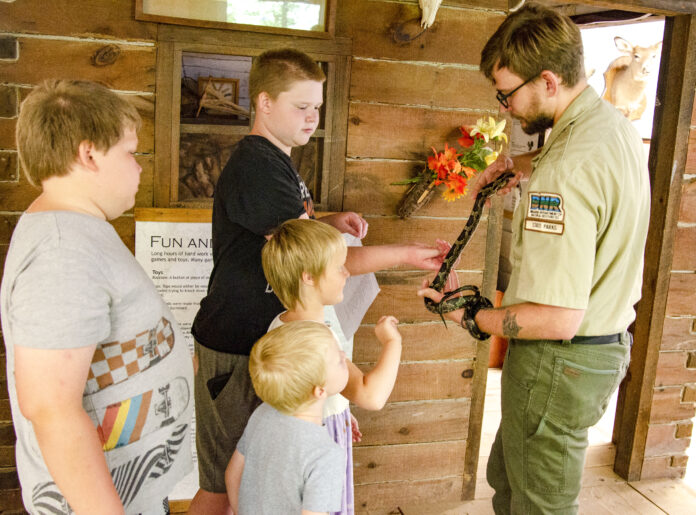By Don Steen ~ Staff Writer • reporter@psci.net
It’s officially summer vacation season, and the local tourism industry is in full swing. While the amusement park and other amenities in Santa Claus remain a primary draw, there’s been plenty of traffic to Lincoln State Park down the road. Park officials are working hard to help accommodate guests, including several regular events to educate visitors on the natural wonders the park has to offer. One such program is Snakes Alive, one rendition of which ran last Wednesday.
Snakes Alive was hosted by Noah Schulz, a Santa Claus native who joined the Department of Natural Resources this spring after returning from an Army National Guard deployment to Niger. Schulz remarked that it has been a welcome change of scenery to live and work surrounded by Indiana’s forests. He was deployed to the desert areas in the north of Niger, leaving little green to be seen.
“It’s great,” said Schulz. “I love it.”
He also noted that he got quite familiar with some of the world’s most deadly snakes while serving abroad. Schulz had encounters with several saw-scaled vipers, a snake one has to watch out for due to their highly dangerous venom and aggressive nature. He also had to be on the lookout for the black mamba, one of Africa’s most-feared snakes due to the toxicity of its venom and rapid onset of symptoms following a bite. Fortunately, Schulz never had a run in with that particular species.
Comparatively, Indiana’s snakes are much more welcoming. Schulz hosted a group of visitors at the Nature Center with a midland rat snake and king snake draped around his arm.
Of the 32 native snake species in Indiana, only four are venomous. The eastern massasauga rattlesnake and timber rattlesnake keep their range further north. The cottonmouth was once found in a small corner of Southwestern Indiana, but no confirmed sightings have been reported in the last decade. Only the copperhead remains ubiquitous in the local area.
One copperhead is kept in captivity at the Nature Center, allowing park guests to recognize its distinct coppery scales and dark brown, hourglass-shaped markings. Bites are quite painful and require medical attention, but are also rare and seldom fatal. The copperhead generally freezes when startled, relying on camouflage to avoid detection. Most bites occur when a human accidentally steps on one.
Schulz also provided a quick rundown of what one should do in the event of snake bite. If possible, it is advised to take a photograph to help identify the snake for medical professionals. Contrary to what one might see in films, one should not slash the wound with a knife, attempt to suck out the venom, or apply a tourniquet. Rather, one should try to keep calm and rest the bitten area to avoid circulating the venom too quickly. The first order of business should be to call for medical help, regardless of whether symptoms have set in.
For the most part, snake bites aren’t a particularly huge concern at Lincoln State Park. Schulz demonstrated this by showing off some of the park’s native species and elaborating on their habits.
The black king snake, for example, is quite common. Most adults are about three to four feet long and mostly black with a few yellow speckles. Schulz noted they are particularly nice to have around, as they keep rodent populations under control and also prey on copperheads.
The midland rat snake is arboreal and an adept climber. Schulz demonstrated its ability to firmly hold itself around a tree limb (or his arm in this case) solely through muscle action. These snakes are also nice to have around due to their rodent-focused diet.
Those in attendance got a chance to touch both species as well, though Schulz had some helpful advice. Kids were told not to pet downward, to avoid causing discomfort for the snake. They were also told not to interact with snakes in the wild.
The Nature Center had plenty of other information about the park and its critters as well. Preserved examples of various animals, such as beavers, geese, owls, etc. were on display in mock ups of their natural habitat. Some species no longer common to the area were also on display, such as black bears, bob cats, and such. The center also has the bones and teeth of a pre-historic mastadon on display, from a specimen recovered near Vincennes.
Local snakes can also be seen at the center outside of official events like Snakes Alive. The copperhead resides in a tank near the restroom. Other reptiles on display include a set of turtles, including a large snapper that resides in a large tank of water in the middle of the exhibit.
Featured Image: A group of kids reach out to pet a snake held by Noah Schulz, a member of the Department of Natural Resources




A gallery of snakes were shown to the group of attendees, each being professionally handled by Noah Schulz

Noah Schulz converses with the group to answer any and all questions they may have about snakes

Aside from all of the snakes, a snapping turtle was also there for visitors to view

A view from the fire tower at Lincoln State Park






